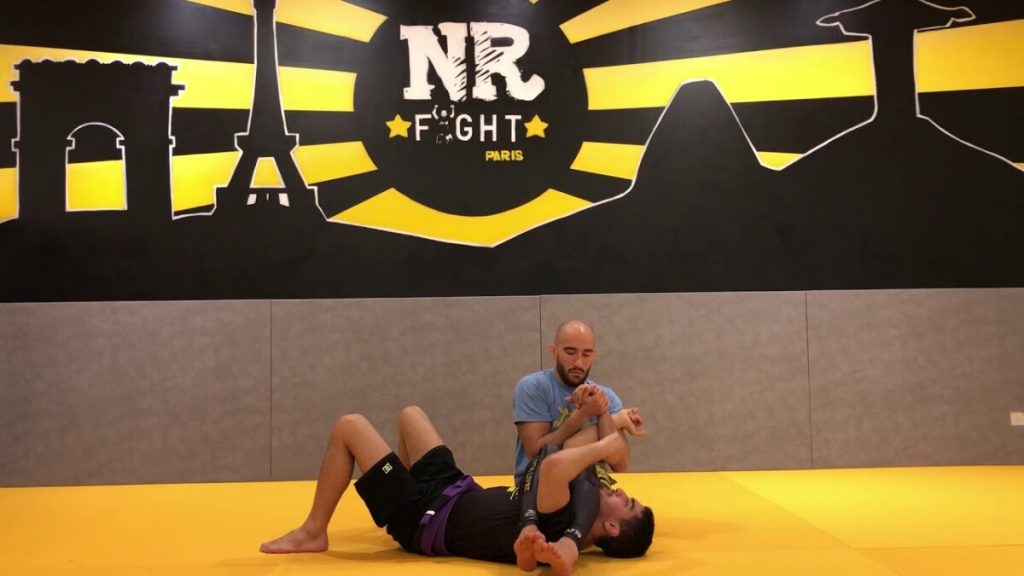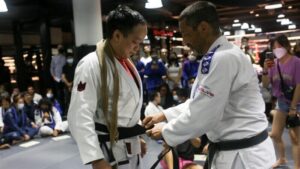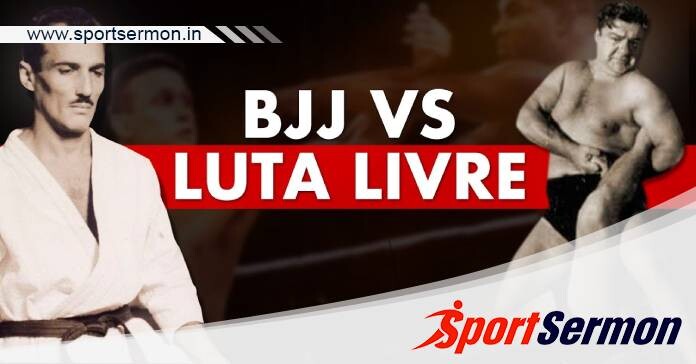Luta Livre Vs BJJ: While Brazilian Jiu-Jitsu is currently considerably more popular than Luta Livre, the two fighting sports used to engage in intense competition as they fought for dominance in grappling. BJJ and Luta Livre originated in Brazil after Japanese judoka Mitsuyo Maeda arrived to teach Kano Jiu-Jitsu, which is now known as Judo.
Jiu-Jitsu is a form of gentle art, and “Luta Livre” is a Portuguese word that means wrestling in English. It is important to note that Luta Livre is not at all the same as BJJ, despite what some people may initially believe. These combat styles are completely different from one another due to their unique tactics and ideologies. For instance, BJJ players aim to obtain advantageous positions before focusing on submissions, but Luta Livre teaches submissions first. Additionally, Luta Livre uses certain BJJ techniques that are prohibited, like as strikes.
During the early 20th century, Helio Gracie and his brothers studied under Maeda in Rio de Janeiro and eventually founded BJJ. To establish BJJ, the Gracies altered some of the Judo techniques they had studied and created some original moves of their own.
As an overweight youngster, Euclydes “Tatu” Hatem had a fascination for catch wrestling, which led him to start Luta Livre. Hatem had training from Orlando Americo da Silva and Rufino dos Santos, two skilled wrestlers. From the 1930s to the 1950s, he participated in catch wrestling matches and was nearly invincible at that time.
In a memorable battle in 1940, Hatem triumphed against George Gracie. The triumph cemented Luta Livre’s reputation as a fierce grappler and created the conditions for one of the most bizarre rivalries in the annals of combat sports.
Vale Tudo and Esportiva are the two primary forms of Luta Livre. The current mixed martial arts have their roots in Vale Tudo, which permits both attacks and submissions. Luta Livre’s sports variant, Esportiva, resembles no-gi BJJ quite a bit.
You might also be interested in reading this: Motivational BJJ Documentaries You Ought to See
The Background of Luta Livre and Brazilian Jiu-Jitsu

When the Gracie family began instructing others in their new combat technique, they were among the wealthiest families in Brazil. A large number of their pupils were wealthy individuals who could afford to buy a gi for their training. Because Luta Livre did not require the purchase of a gi in order to train, it was more appealing to the average Brazilian. Students in Luta Livre required shorts, T-shirts, and an open attitude, much as it is now with no-gi BJJ.
One of the earliest differences between the two genres was that. While Luta Livre was considered the combat style of the working class, BJJ was seen as a more elite sport. The battle between these two techniques became more intense after Hatem’s 1940 victory over George Gracie gave Luta Livre legitimacy.
Both sides had no idea that their competition had only just begun. The battle inside a Luta Livre gym between Charlie Gracie and a Muay Thai fighter named Mario Duma escalated. Eventually, punches were thrown. Charlie Gracie was the one who suffered the most, yet some people theorise that it was because of a lady that both men were seeing. At this moment, Luta Livre was up 2-0 against BJJ.
Angry about the loss, the Gracie family’s elder members gathered together a few of their students. In order to challenge Duma, they went to the gym where he exercised. Having accepted the challenge, he ultimately lost the battle.
The Gracies’ retribution did not end the animosity; three-on-three bouts were arranged to see which school was the best. Many observers claimed that the referees were biased in favour of BJJ after the match finished in a tie.
When Rickson Gracie and Hugo Duarte got into a fight, the animosity between BJJ and Luta Livre reached an all-time high. The battle was supposed to happen between the two guys, but Duarte reportedly withdrew, saying he needed more time to train.
Rickson had wanted to leave Brazil and introduce BJJ to other areas of the world, so he had no intention of waiting that long. He confronted Duarte there after learning that he frequently visited one of the nearby beaches. A brawl was inevitable, as Rickson repeatedly mounted Duarte and delivered savage ground strikes. Given that Duarte didn’t appear to have any solutions for Rickson, it dealt a fatal blow to Luta Livre’s standing.
The humiliating loss severely damaged Duarte’s self-esteem. He rounded up roughly sixty of his pupils and went to a nearby Gracie Academy to pick fights in 1988. According to several eyewitnesses, Duarte’s posse rushed the Gracie Academy armed with knives, firearms, and other weapons. Helio Gracie was fortunately present at the school at the time and was able to diffuse the situation and come up with a safer alternative. To resolve their disputes, Duarte and Rickson decided to fight in the parking lot. This time, Rickson came out on top once more, and Duarte was able to concede defeat.
The victory greatly enhanced BJJ’s standing since it was thought to be a more effective combat technique than Luta Livre.
The competition was far from ended at that point. Three fighters from BJJ and three fighters from Luta Livre faced off in a brutal fight in 1991. The three BJJ competitors won their matches, raising the profile of the sport in Brazil.
The animosity between Luta Livre and BJJ went out of hand when Renzo Gracie faced Eugenio Tadeu in a BJJ vs. Luta Livre battle. When Renzo responded after being kicked by onlookers during the fight, a riot broke out, damaging the area and injuring other individuals. Following widespread coverage, the Brazilian government intervened and ordered both parties to end their dispute or risk facing legal repercussions. One of the craziest rivalries in martial arts history came to an end as a result.
After dominating the early days of mixed martial arts with BJJ legends like Royce Gracie, BJJ evolved into what is perhaps the most effective martial art in the world. Since then, luta livre has lost some of its popularity and is still only used by a select few people as a fighting technique.
Luta Livre Vs BJJ: What Is The Difference Between Both?
Get to know the difference between Luta Livre vs BJJ. Let us know in the comment section below:

After discussing their respective histories, let’s examine some of the key distinctions between these two martial arts:
1) Uniforms
When training, BJJ players usually don an attire known as a gi. The traditional BJJ clothing has roots in ancient Jiu-Jitsu. The ensemble is made up of trousers, a belt and a jacket made of cloth. The colours of the belts correspond to each student’s rank.
In BJJ, there are five different ranking systems: white, blue, purple, brown, and black. Many contemporary BJJ schools employ stripes or colours that aren’t typically used in BJJJ to divide white belts into various ranks. Since becoming a blue belt can require up to two years of study, many teachers now divide the white belt level into various grades in order to honour white belt successes as their abilities advance. In addition to being utilised to perform certain techniques, like a collar choke, the gi keeps hands from becoming slick by absorbing perspiration during rolling.
On the other hand, traditional attire is not worn by Luta Livre pupils. Usually, shorts are all that is required and t-shirts are optional.
2) Combat Theory
On the other hand, traditional attire is not worn by Luta Livre pupils. Usually, shorts are all that is required and t-shirts are optional.
Being in the closing space is not as important in Luta Livre as it is in BJJ. They are trained to offer opponents room to manoeuvre, allowing them to seize the chance to go from an attack to a surrender. These, in their opinion, are some of the finest times to obtain contributions.
Additionally, BJJ focuses more on securing dominant positions and submissions through the use of leverage during bouts. Originally, the approach was designed to help smaller fighters overcome stronger, larger opponents. Instead of relying on leverage, Luta Livre emphasises the use of mobility to generate both offensive and defensive possibilities.
3) Colours of Belts
The belts used in BJJ are white, blue, purple, brown, and black, as we previously explained. Each student’s journey to the next level is different, although most take close to two years to complete each promotion. The majority of people need more than ten years to obtain a black belt in BJJ. After each colour rank, many teachers add stripes to each colour to represent their pupils’ advancement.
The belt hues that Luta Livre utilises include orange, white, blue, purple, brown, and black. Many practitioners work their way up to higher levels after two years of training.
4) Competition
The scoring systems used in BJJ and Luta Livre contests differ significantly. All lower-body assaults, including leg locks and heel hooks, are prohibited in BJJ tournaments, with the exception of experienced combatants (brown and black belts). Since most BJJ schools don’t emphasise leg locks and related techniques as much as other grappling disciplines like Sambo and Luta Livre do, most students aren’t bothered by the regulation.
Leg locks are permitted in Luta Livre for all skill levels, including novices. Ankle locks are the only method available to beginners; those with blue belts and higher can employ whatever technique they want.

